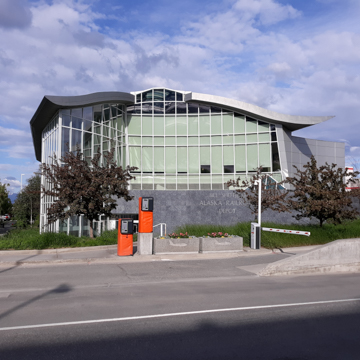You are here
The Bill Sheffield Alaska Railroad Depot
The Bill Sheffield Alaska Railroad Depot Railroad Depot opened in 2003 with the goal of connecting the Ted Stevens International Airport to Downtown Anchorage and beyond via rail. The depot and the branch line that connects to downtown were completed at the same time. It is named for the former governor and director of the Alaska Railroad, Bill Sheffield. The proponents of the depot envisioned creating a public rail corridor that would spur greater interest in public transportation throughout Southcentral Alaska, from Girdwood, located 35 miles south of Anchorage, to the Matsu Valley, 35 miles to the north. The Alaska Railroad is a Class II railroad that is equipped for freight and passenger service. At present, the depot is mostly used seasonally to bring tourists from the airport to their hotels or other destinations. It is also rented out as an event space.
With its steel and glass exterior, the Depot collects natural light and presents a breezy open space, ideal for social gatherings. It connects to the airport's terminal through a tunnel. Rail service passengers catch the train on an elevated platform that exits the airport to the east before heading north towards downtown. Visitors who are not arriving by flight may use the airport parking lot, situated to the north of the terminal, to access the depot. Built at a cost of $28 million and designed by KMD Architects (Seattle), the depot is 24,000 square feet. In addition to the open concept and impressive glass exterior that extends from the ground level to the top of the facility, primary materials include Alaskan stone and wood interior finishes. It received an American Institute of Architects Citation Award in 2004 and is well-regarded for its attention to detail and modern style. It possesses a uniquely Alaskan sensibility with the inclusion of Indigenous Alaskan art and landscape paintings that capture the rugged mountains, expansive oceans, and vast wilderness that we associate with the state. The windows open up to reveal a scenic span of the Chugach Mountains just five miles to the east and southeast.
Although the funding came through federal appropriations secured by the late Senator Ted Stevens, the building was a lightning rod of controversy and is upheld as an example of misspent public funds. Critics have pointed out that the original intent was for the Depot to serve between 120,000 and 200,000 passengers per year, a mix of tourists and residents who would use it year round. But recent estimates have placed the total number of passengers at roughly 20,000, nearly all of whom clustered in the summer months. As a result, the Depot has been generally closed through the winter in recent years. A transportation corridor for commuting Alaskans who use public transportation has not developed. The building reflects an ongoing debate in Alaska over how best to use federal funds and taps into a longer pattern of so-called “megaprojects” that have promised to contribute to the economic and civic life of the state but have underdelivered.
References
Rosemary Shinohara, “Anchorage Airport train depot echoes silence,” Anchorage Daily News, March 2, 2010.
Bill Sheffield Alaska Rail Depot Fact Sheet, Alaska Department of Transportation.
Writing Credits
If SAH Archipedia has been useful to you, please consider supporting it.
SAH Archipedia tells the story of the United States through its buildings, landscapes, and cities. This freely available resource empowers the public with authoritative knowledge that deepens their understanding and appreciation of the built environment. But the Society of Architectural Historians, which created SAH Archipedia with University of Virginia Press, needs your support to maintain the high-caliber research, writing, photography, cartography, editing, design, and programming that make SAH Archipedia a trusted online resource available to all who value the history of place, heritage tourism, and learning.





